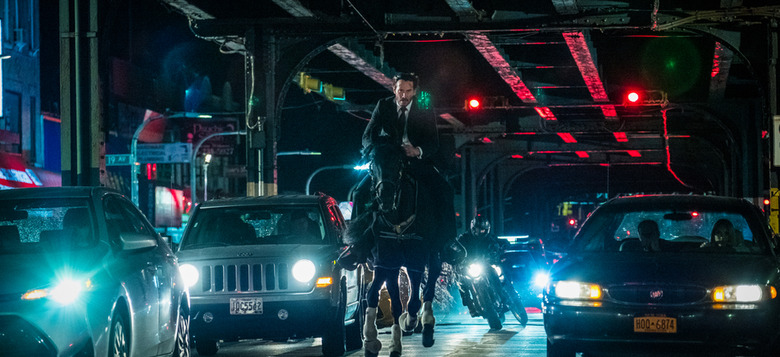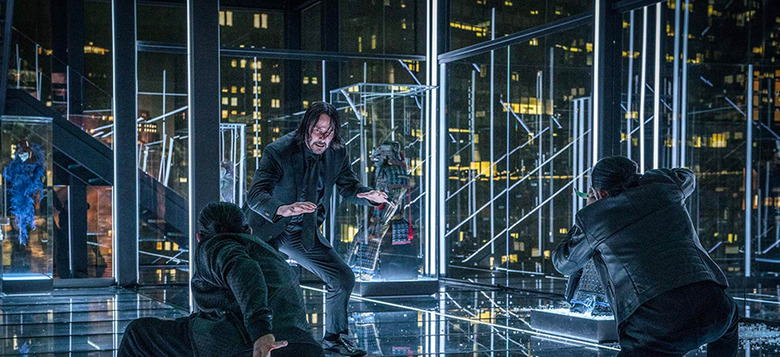The Poetic Action Storytelling Of The 'John Wick' Franchise
In an era where action has become a secondary device used to prop up character and stories, it would be easy to dismiss the John Wick movies as mindless action movie fun. But if you look beyond the gore and the high body counts, each John Wick film, including the latest release John Wick: Chapter 3 – Parabellum, deliver immaculately choreographed, indescribably intense sequences that deserve spots in the action movie hall of fame.
But the feverish, frenetic Keanu Reeves-led films directed by Chad Stahelski have done more than elevate headshots into high art. The John Wick films have managed to distill the essence of great action films from around the world — in loving homage to Hong Kong cop movies, to Korean thrillers, to Indonesian martial arts movies — and accomplish what most Hollywood movies still struggle to do: make the action part of the storytelling.
Spoilers for the John Wick movies follow.
The Language of Action Movies
"Jackie [Chan] said something very interesting: That the audience don't know the rhythm is there until it's not there." That's according to a video by Tony Zhou in his film analysis series Every Frame a Painting examining how the editing and camera angles can define how audiences experience an action scene.
That rhythm, that dance between fighters that embodies Hong Kong martial arts films like those of Chan, Bruce Lee, and Jet Li was something that Stahelski brought forward in his John Wick films, heavily influenced by his own early studies in martial arts choreography. "Early on, I got into martial arts choreography, studying the Hong Kong guys – and it was all from Jackie Chan saying "Go watch dance! More like dance!" Stahleski said in a 2017 Empire interview. "We were very conscious of that from the first one. I don't want to reach and say it was a musical, but it was meant to be a live performance based on dance."
Take "gun-fu," for example: the buzzword that helped turn John Wick into the cult action movie classic and launch a whole franchise of headshots and balletic brutality. Coined by Stahelski himself, the fighting style is is described by the director as a combination of "Japanese jiu-jitsu, Brazilian jiu-jitsu, tactical 3-gun, and standing Judo," but the genre has much deeper roots: there's the Hong Kong action movies of the '90s spearheaded by the heroic bloodshed virtuoso John Woo, the kung fu movies popularized by Bruce Lee and Jackie Chan, and the Chinese genre of wuxia that inspired both.
Wuxia serves as the backbone of much of Hong Kong action cinema, both narratively and aesthetically. The literary genre stretches back all the way to the Qing dynasty, in an amalgam of ancient Chinese youxia fiction — which follows wandering folk heroes who help commoners in need — and Japanese ronin stories. But wuxia would find its modern footing in acclaimed films like Ang Lee's Crouching Tiger, Hidden Dragon and Hou Hsiao-Hsien's The Assassin, which are marked by operatic set-pieces and fantastical fight sequences that more resembled a dance rather than a battle.
The gravity-defying sequences in wuxia films would be revolutionized by Woo in his '90s Hong Kong action films, which followed a hardboiled protagonist, usually played by Chow Yun-Fat, as he mows through henchmen in a balletic show of gun play and slow-motion bloodshed. "Woo's innovation was to treat cinematic gunplay as an aesthetic, not just frenetic, experience," Vulture describes in an article digging into the roots of gun-fu. "He shot his action scenes with deliberate precision and panache, upping the ante in every respect: Woo gave Chow Yun-fat two guns instead of one, made extensive use of slow motion, and had his heroes and villains expend as many bullets as possible."
Hong Kong cinema would famously take Hollywood by storm with 1999's The Matrix, which fittingly starred Reeves and featured Stahelski as his stunt double, and served as the template by which John Wick would act as a melting pot of action movie influences. But not only were Hong Kong action films part of The Matrix's DNA, but cyberpunk anime like Ghost in the Shell and Akira. It was action filmmaking at its most heightened and ambitious — and it would all quickly fall out of favor once Hong Kong cinema mania left Hollywood following a barrage of bad Matrix knock-offs. Martial arts cinema moved back to VOD and B-movies, or back across the ocean to East Asia, where it has been quietly evolving out of sight of Hollywood.
The language of martial arts movies is changing. In films like The Villainess and The Raid, action films are starting to look more like video games, with extended sequences in both filmed in long takes in which one central character bulldozes through impossible hordes of henchmen at ridiculous speeds — sometimes splattering a bit of blood on the camera lens for that extra bit of gritty realism. The Villainess doubles down on this by filming its entire opening through a first-person POV shot. It strips away the stylish bravado of Woo's films, and the operatic wuxia-meets-cyberpunk style of The Matrix.
And that's where we come to the John Wick franchise, which fuses together all these elements in a neon-drenched noir that is at once a ronin tale, a wuxia fantasy, a Hong Kong blood opera, and a video game-esque crime thriller. The series is as much a love letter to the martial arts genres as it is a perfect melting pot of influences that create a truly unique action franchise. Among the inspirations that John Wick: Chapter 3 can name are martial arts classics like Game of Death, modern martial arts hits like The Raid and The Villainess, and everything from classic art to classic Greek myths and classic silent films. And, of course, the acrobatic wiliness of Buster Keaton.
Action as Storytelling
In a typical Hollywood blockbuster, the action is mainly contained in set-pieces. And while some are operatic and thrilling like those of the Mission: Impossible films or Mad Max: Fury Road, most have become rote and visually confusing — marked by rapid cuts and shaky cameras to hide the actual fight choreography under the pretense of suspense. The latter is the kind you more frequently see in many superhero films, in which the action is used as interludes to break up the stretches of dialogue, while the characters and the narrative take priority. But in many Asian action films — Chinese, Korean, Indonesian, and more — the action drives, and even becomes, the narrative. So while the John Wick movies may appear to have the barest of plots, that simplicity only gives a better platform for the action to take center stage.
Tony Zhou's Every Frame a Painting video points out that in Jackie Chan's films, the action is the comedy. Jackie Chan always begins a fight as an underdog and fights his way up, sometimes literally, and often using whatever items he has around him. Similarly, the action is the story in John Wick. John Wick begins as a man who has long been out of the fight and is forced back into the world of assassins where he becomes a pure force of vengeance. It's a relatively simple story that plays out in each hit that John Wick lands and each headshot that he makes and later, a story that starts to leave its marks all across John's body.
Since the first 2014 John Wick became a small but potent martial arts cult hit, each film has gotten progressively bigger, the stakes have become higher, and the titular assassin has only gotten more fatigued. In the first film, John Wick is angry and ruthless, his signature "gun-fu" in full display in his sharp hand-to-hand fights and in the punctuating blasts of his fatal headshots. Three years later, as John Wick: Chapter 2 dramatically expands the scope of the film, each of the film's action set-pieces scream opulence while John Wick carries himself more smoothly — like James Bond meets a video game fighter.
By the end of the first fight in John Wick: Chapter 3, you can see that John Wick's moves are not as graceful, even sluggish when up against the sharp, quick movements of the numerous Asian martial arts fighters populating this film. "He's getting slower," one of his nemeses remarks as he and another of Zero's henchmen (played by The Raid actors Yayan Ruhian and Cecep Arif Rahman) nearly beat John Wick to a pulp. "Yes, but he's still John Wick," the other replies.
John Wick's changing opponents and their unique fighting styles are representations of each film's story as well: In John Wick, his primary opponent is a slimy Russian gangster (Alfie Allen) and his powerful father Viggo Tarasov (Michael Nyqvist), the head of the Russian crime syndicate in New York City. With the hordes of Russian thugs, John fights dirty, inflicting as much pain and merciless violence on them as they did on his poor dog. But in John Wick: Chapter 2, John goes up against the wealthy and elite crime lord Santino D'Antonio (Riccardo Scamarcio) and his polished security forces led by Ruby Rose. In these fights, John is sleeker and more well-prepared with weapons — with the exception of the thrilling subway knife fight between him and Common's Cassian.
And in John Wick: Chapter 3, John is more often than not left to his own devices against armies of well-trained assassins that are frequently of Asian descent — the most diverse of the John Wick films and the most overt in its homage to the East Asian martial arts flicks that influenced it. Dacascos spoke to /Film about how he customized his villain's fighting style to be the best foil against John Wick, saying, "Obviously Zero knows that John is fantastic with his hands grabbing and throwing. So he's not going to engage him up close unless he has to. He's going to use more striking or kicking more movement, like a mosquito that just doesn't go away. That's the idea. So there's different conflict styles in there."
John's frequent repetitions of "consequences" emphasizes karma and all that it reaps, which plays out on his own weary, battle-worn body. On the run from half the city, John is forced to rely on knives, katanas, and books, and even when he gets his hands on "lots of guns," he's denied the quick satisfaction of his signature headshot thanks to improved body armor. He gets more cuts, bruises, brands, and artery-nicking injuries than ever before — with whole sequences devoted to throwing Keanu Reeves through glass panels or seeing how much he can be beaten before he gets back up. It's a return to the scrappy, bootstraps nature of the first film that made John Wick such a lean, focused action flick. Yet John Wick remains a sheer force of nature that — no matter his speed or fatigue levels — keeps plugging on until only bloody bodies and devastation are left in his wake.


